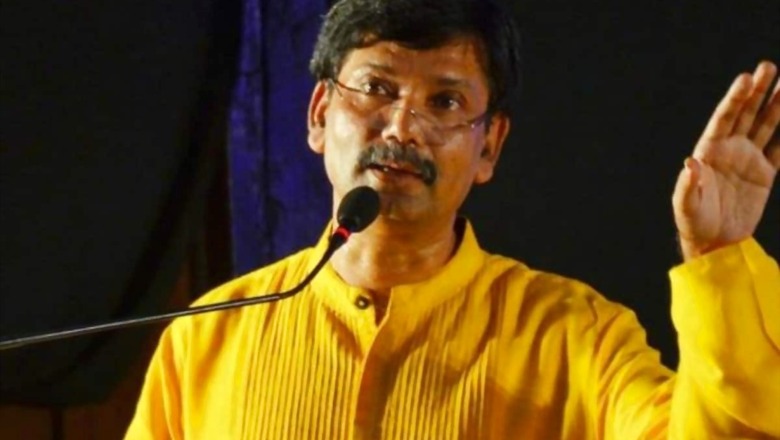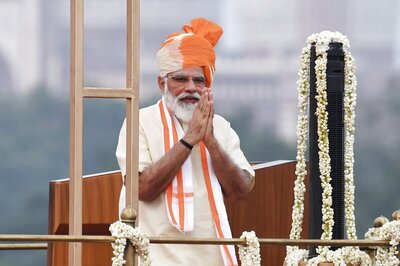
views
Badri Narayan, a 56-year-old academic, shines light on what he calls the “new RSS emerging in the grassroots level” in his book, Republic of Hindutva, which came out on March 15. In an interview with News18.com, Narayan says the Sangh is carrying out the work of appropriating marginalised and subaltern identities, and is doing that with flexibility in order to avoid any resistance from the people it is trying to assimilate. He says that even so-called secular parties are using the Hindutva language today as a countermeasure while dealing with the Sangh’s shadow. Edited excerpts:
Q. Can you tell us about your book, Republic of Hindutva. Why did you want to write a book on the Sangh Parivar? There have been many recently.
You can get the reply from the book, and not from the author. But then, I would like to tell the readers that I wrote this book because I saw our society rapidly re-organising itself on Hindutva bhava (Hindutva sentiment).
It is not new, as this Hindutva bhava was part of the life of a section of people — which is being reframed now so that it can produce a “Hindutva common sense (an understanding of Hindutva)” among people.
“Hindutva common sense” is being evolved among a section of our society, cutting across the various social classes, including the marginalised section, the poor and the subalterns. We can easily observe the emergence and the presence of a vocal and assertive Hindutva public sphere in recent days.
This “Hindutva common sense” is organically linked with the formation of the “broader Hindutva identity” that is conceptually called — “Samagra Hindutva (the whole Hindutva)”, which is produced as socio-cultural bhava. But on the way, it has developed its own politics, and that is being reflected in the constant success of the BJP (Bharatiya Janata Party) in our electoral democracy.
In my study, I found that the RSS (Rashtriya Swayamsevak Sangh), through its works at the grassroots, has appeared as sutradhar (key character) of this new paradigmatic shift. The Sangh is facilitating this process of social change by inventing, reviving and reinterpreting cultural memories of the people and doing various sewa karya (acts of service).
It is working to forge a grand Hindutva community by its inclusion and appropriations of all opposites — fragmented and fractured sections of society — in one narrative.
I write this book to understand why and how the RSS has emerged as a social force, which is reshaping our society in its own way.
Q. You write in your book that there is a new RSS emerging, but we have the same old approach towards countering and understanding it. Can you elaborate on this?
I have observed that in our political discourse, various stereotypes about the Sangh are dominant — most emerged 40-50 years ago.
However, in these 50 years, the Sangh has changed a lot. After the 1990s, due to the introduction of a new liberal economy, the Indian society and its issues have changed. And I think the changes in the Sangh were inevitable as well because it had to respond to a new social complexity.
New issues such as ecological concerns, transgender issues, and questions of water and virus appeared before them as test cases, and they handled them successfully. So, in one sense, now we have a new version of the Sangh, which is well-equipped with the power of new technology and modern social discourses and responding to democratic questions on its own.
The Sangh has reinvented itself as a re-incarnation of our older social reform movements, and adopted a more organised way to pursue its commitment and goal. By this I mean the way Arya Samaj, Ramakrishna Mission etc. worked, using karya (acts of social service), vidya (education), pravachan (sermons). Similarly, the Sangh is applying all these devices to associate with the people.
It evolved appropriation and inclusion as a process to expand itself. However, we still put the Sangh in various binaries, such as Brahminical and non-Brahminical, Hindu and non-Hindu, Hindus and Muslims. The Sangh has expanded its boundaries and tried to make some of these stereotypical binaries obsolete, by its culture of public actions.
The book tells in detail how the new RSS emerged. I would like to recount a popular saying in this context of the new RSS and old approach: “Elephant moved ahead and its shadow remained there.”
Various political parties are struggling with Sangh’s shadow, and they must reinvent their understanding of the Sangh, or else lose the battle.
Q. The RSS recently concluded its ABPS (Akhil Bharatiya Pratinidhi Sabha) and Dattatreya Hosabale from Karnataka is the new general secretary. How do you think Dattatreya’s election is going to change the way the RSS and the BJP work together?
The election of Dattatreya Hosabale tells a few things. First of all, it reflects their urge to reshape the Sangh in consonance with the new condition of the society and nation. It also shows that the Sangh will evolve itself as more interactive with various social and linguistic groups in coming days. He is quite competent in dealing with modern questions of our society, produced due to implementation of neo-liberal economy, globalisation and the regime of virus.
I think, with this change, the RSS and the BJP both will ally more effectively to work together for creating Hindutva as a long-term social-cultural-political identity. Politics of power has its own limitations, but the BJP will also contribute in its own way in achieving goals determined by the Sangh or vice-versa.
Q. In your book you have talked about Sangh’s new appraisal of BR Ambedkar, where the Sangh is downplaying Ambedkar’s stand on caste system to make him “relatable”. Can you elaborate on how the RSS is making Ambedkar “relatable”?
The Sangh, in its discourses, tries to remember Ambedkar in a way so that it may not be used by its opposite forces to polarise people, especially Dalits, against Hindutva. They remember Ambedkar as one of the great social icons and support his arguments to provide respect, dignity and space in their entire project of remaking the Indian nation.
Q. How is the RSS Dalit outreach different from the earlier times?
The inclusion of Dalits in the Sangh’s Hindutva is one of the most important plans of action. Reaching to marginal sections with reinterpreting their histories and icons creates for them the space to relate with subalterns. The sewa karya and samrasta campaign (social work and policies of inclusion) evolve their (the Sangh’s) associations with the marginal sections. The Sangh is working to develop a form of subaltern Hindutva, which is explained in my book.
Q. The AAP has come out with an agenda to make students “kattar deshbhakts”, and also raised the Jai Shree Ram slogan. How do you see the current change in regional parties in terms of using Hindutva language?
In fact, now Hindutva has emerged as the dominant narrative of the Indian political culture. Earlier those who wanted to prove themselves secular…they are compelled to move towards Hindutva, either soft Hindutva or hardcore Hindutva. With time, the Hindutva movement has evolved as a social bhava…politics is not shaping this bhava. The Sangh is shaping Hindutva social bhava, which is producing its own politics.
I would like to say that those who want to contest Hindutva — the AAP (Aam Aadmi Party) and the Trinamool Congress (TMC) — will have to derive their language from Hindutva itself.
Q. In the book, you have spoken about the RSS politics of inclusions, assimilation and appropriation of subaltern identities. What is your observation: is appropriation of other identities working for the RSS and the BJP, and how?
Yes, it is working well among the most marginal and tribal people of India. The Sangh method is quite interesting. They don’t demand anything like vote or support. All they ask for is sewa karya, which slowly attracts these communities towards the pracharaks. And from the pracharaks, the Sangh’s messages disseminate among people. Most of these communities have also deep aspirations for getting religious dignity and religious space in the society. The Sangh assimilates them in response to their urges.
Q. You have highlighted the steps of outreach and their (the Sangh’s) success, but there are other cultures resisting it. For instance, Jharkhand’s new resolution allowing tribal to identify as non-Hindus. According to an RSS affiliate, it is a “conspiracy”. Can you tell us about the resistance the RSS is facing in this assimilation?
True, we find such cases of dissent against the Sangh’s methods of inclusion of these communities. As I see, Sangh is a very persuasive organisation and has multiple strategies to synthesise the opposites. We need to see how they handle dissents against their arguments.
But let me tell you, when the task of appropriation starts, it is met with resistance. When faced with any such situation, the RSS changes its stand for acceptability in that society. If they become rigid, then there will be resistance. For instance, Mohan Bhagwat saying that some parts of Bunch of Thoughts, which was written by MS Golwalkar, are not relevant today. If they don’t change they will face difficulties in carrying out their work of assimilation.
Read all the Latest News, Breaking News and Coronavirus News here



















Comments
0 comment